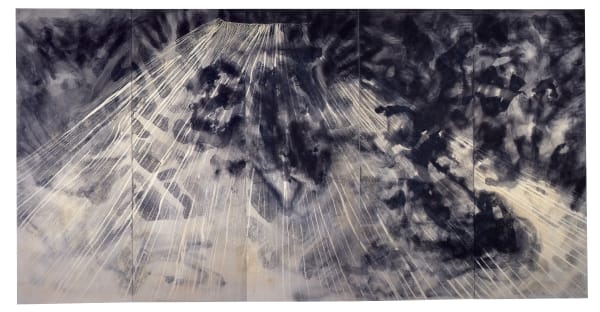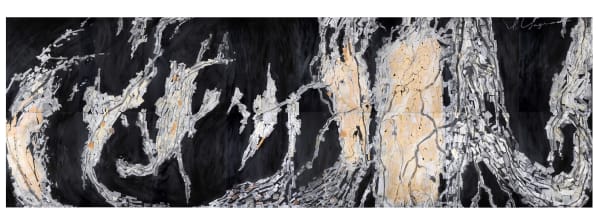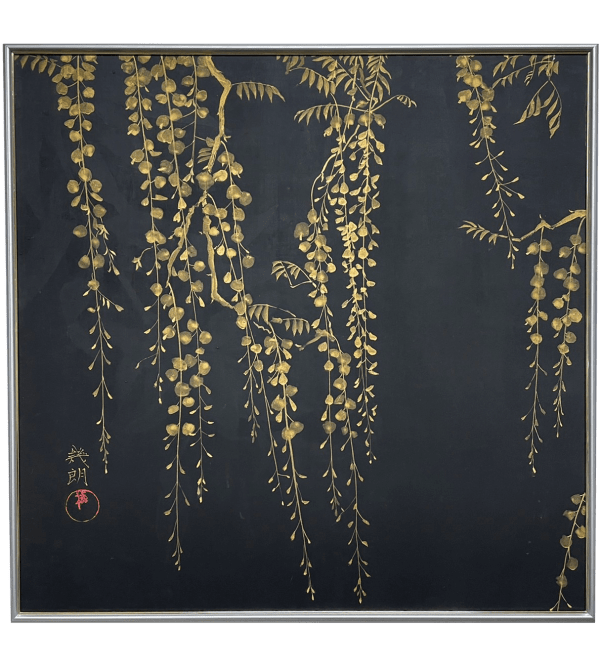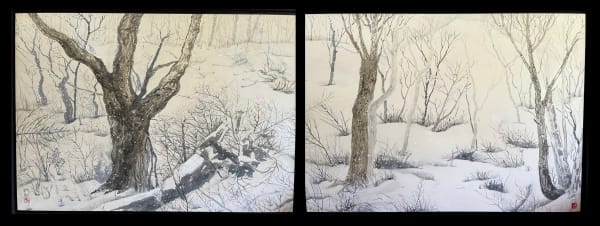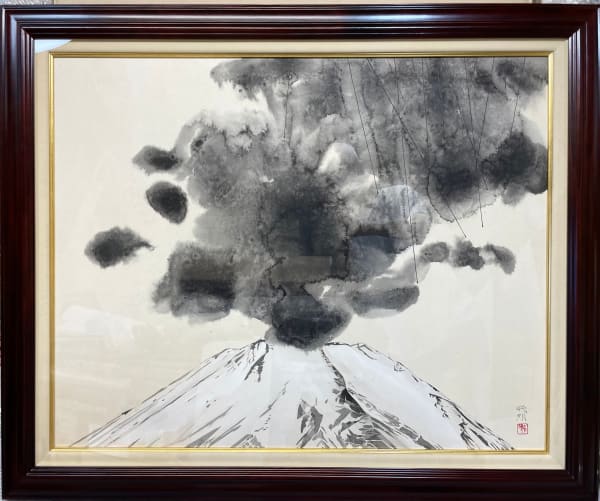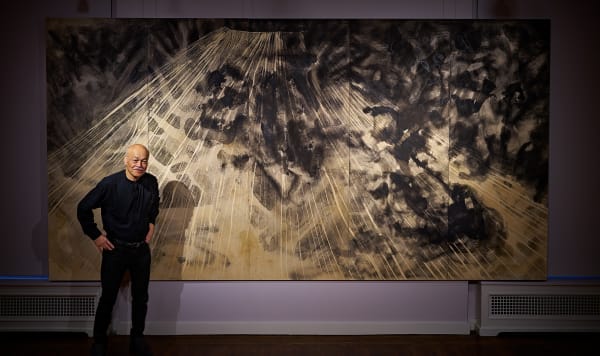Ikuro Yagi: Grand Nature
-
OverviewExhibition opens Thursday, October 10, 2024
- Opening Reception with Yagi: October 10, 6–8 PM
- All visitors are welcome: Mon. to Sat. 11 AM to 6 PM
- Private viewing by appointment only.
-
Director's Letter

Yagi's World
— Shoko Aono, September 2024
As Japan’s highest peak, people have revered Mt. Fuji since ancient times. Ikuro Yagi was born in Yoshida-machi, Haibara-gun, Shizuoka Prefecture looking on the sacred mountain. Framed by the graceful scenery of Mt. Fuji and the great Oigawa River flowing into Suruga Bay, as sea breeze intersects with sunlight, is the bright hometown where Yagi established his atelier. The painter, while perfecting his discipline in the techniques and mediums of Japanese Nihonga painting traditions—Sumi ink bokusai-ga and mineral pigments iwa-enogu—over half a century, follows his pursuit to express originally realized and uncharted ideas. In particular, as a Nihonga painter living in the modern time, what is Sumi ink suiboku-ga whenpushed to its present limits?
Ikuro Yagi’s paintings do not solely depict nature, nor solely humanity. Rather, they show the relationship between nature and human beings. A majestic beauty waiting dormant, the active volcano is the dreadful truth of Mt. Fuji, and this close proximity is perhaps a familiar reality. “The sort of works that I want to paint now are to get the blood flowing,” Yagi says. He embeds the motif of nature in all new features, painting images that extend to the current societal symbols of manufactured violent dispositions and war. The dynamic compositions and liberated brushwork integrate not just classical Nihonga—flowers, birds, air, and the moon— but truly human suffering, joy, desire, and prayer so that the quintessence of humanity emerges.
The first New York showing of Ikuro Yagi’s work, this exhibition presents the animal-glue nikawa based iwa-enogu mineral pigment painting, wood panel door itado-e painting, and suiboku-ga ink painting styles all together. Spanning his fifty-year career, the exhibition includes an early piece, ‘Beyond the Forest [Mori-no-Kanata];’ the recently completed ‘Mt. Fuji,’ among other large works; and a new woodblock print collage, ‘Nature,’ making a premier display. Face to face before Yagi's works, the whole body takes on the sense of observing the painting. The spirit jolts involuntarily beyond just a shake; the viscerally felt instinctual sensation is a lasting impression. -
作品
-
Press Release

New York, NY — Ippodo Gallery presents the premier exhibition for Japanese painter Ikuro Yagi: Grand Nature in the United States from October 10 through November 22, 2024. Spanning works from 1984 to 2009, Yagi debuts overseas some of the greatest masterpieces created in his long career. More than 15 painted and collaged works on Japanese washi paper, wood panels, and canvas speak to a universal language of nature and city life in Japan through the visual medium of sumi ink and nihonga. The permeating theme of Yagi’s paintings is the unspoken healing effect of nature on the human soul; a gentle reminder that endless kindness is at the fingertips. The artist will travel to New York from Japan for an opening reception commemorating his first solo show in the U.S.
“Sumi ink is not simply carbon; infusion into the washi paper grants us a sense of holding a piece of nature. Perhaps it is the same sort of sensation as strolling amidst the trees.” Ikuro Yagi (b. 1955) maintains his innovative nihonga painting practice from his home in Shizuoka Prefecture where his roots have long been set. Mount Fuji resides in Shizuoka, and Yagi sees no barrier between man-made spaces and the grand presence of nature which he depicts so prominently. His education brought him to Paris following study under nihonga master Matazo Kayama at Tama Art University and western-style painter Koji Kinutani. The French influence invigorated his approach to nihonga styles, the medium through which he began to depict all sorts of material culture. His vivid paintings of sea creatures, flowers in bloom, and all other sorts of wilderness draw on decorative traditions that defined nihonga painting in the era of ornate interiors during the Edo period (1603-1868).
Beyond the work he has done on behalf of Japan’s Agency of Cultural Affairs, Yagi’s hand has also contributed to temples and shrines throughout the country. Among these contributions is the world-famous Fushimi Inari shrine outside Kyoto, known for the innumerable red torii gates. For generations, nihonga paintings lined temples halls or adorned castle sliding doors; Yagi incorporates these elements as found objects, such as discarded wood from shrines and towns.
Yagi’s ‘Impression Kyoto’ (2003) meditates on wood as a traditional yet impermeant material; the planks transform from something purely functional into a narrative on the passage of time and reconstruction. The transition of nature in a raw state is the heart of Yagi’s characteristic style; powerful brush strokes and layered paper take on a quality evocative of the works of Picasso, whose collages helped reformulate approaches to image-making and tradition. Yagi’s techniques, bearing semblances of Kanō and Hasegawa influences such as Tōhaku’s Pine Tress Screens, uniquely draw together impressionist and abstract modes of depiction while emphasizing the organic appearance and texture of mineral pigments and sumi, washi paper, and wood.
Ikuro Yagi is represented in the collections of museum institutions and spiritual sites across Japan, including the Hamamatsu Municipal Museum of Art, Niigata Bandaijima Museum of Art, Hirano Museum of Art, Shimoda-shi Museum, Hiroshima Prefectural University Art Museum, Nerima Art Museum, Shizuoka Prefecture Museum, Taima-ji, and Zōjyo-ji. His works have exhibited in Japan and Germany, and his paintings have garnered awards including the Takashima Award for Art from the Takashimaya Cultural Fund.
-
Artist Statement

Within nature,
From a void of nothingness, the water surface starts to tremble, flowingly, forest and rainfall are interconnected, and droplets evaporate into mist.
I am awash in the feeling of these sensations as I walk.
The air about the uncoated surface of the washi paper takes on the pulse of a heartbeat.
Sumi ink is not simply carbon; infusion into the washi paper grants us a sense of holding a piece of nature.
Perhaps it is the same sort of sensation as I stroll through the surrounding woods.
I want to leave behind my impression of joy and anxiety to be entrusted to all of us who share the fate of this short, fleeting life.
A darkness within the blackest of black urushi gathers, cut only by the bright moon.
The shrouded black accentuates the life of humanity within the city.
Overlapping layers of paper bear a soft permeating light like that of the shoji screen indicative of the tender movement of the air and flow of time.
Hopefully, the more powerful contrast is felt in the sense of vitality and hope for what’s to come. -
Events
-
Installation Shots

